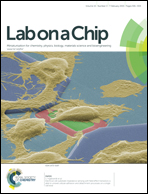Electrochemical pesticide detection with AutoDip – a portable platform for automation of crude sample analyses†
Abstract
Lab-on-a-chip devices hold promise for automation of complex workflows from sample to answer with minimal consumption of reagents in portable devices. However, complex, inhomogeneous samples as they occur in environmental or food analysis may block microchannels and thus often cause malfunction of the system. Here we present the novel AutoDip platform which is based on the movement of a solid phase through the reagents and sample instead of transporting a sequence of reagents through a fixed solid phase. A ball-pen mechanism operated by an external actuator automates unit operations such as incubation and washing by consecutively dipping the solid phase into the corresponding liquids. The platform is applied to electrochemical detection of organophosphorus pesticides in real food samples using an acetylcholinesterase (AChE) biosensor. Minimal sample preparation and an integrated reagent pre-storage module hold promise for easy handling of the assay. Detection of the pesticide chlorpyrifos-oxon (CPO) spiked into apple samples at concentrations of 10−7 M has been demonstrated. This concentration is below the maximum residue level for chlorpyrifos in apples defined by the European Commission.


 Please wait while we load your content...
Please wait while we load your content...